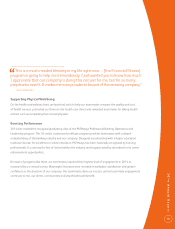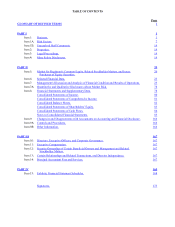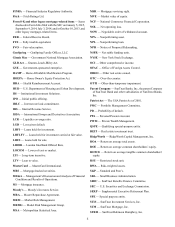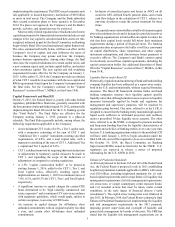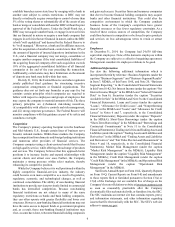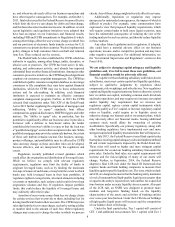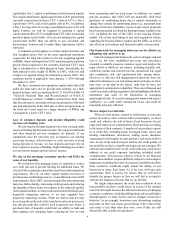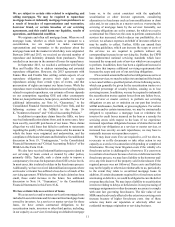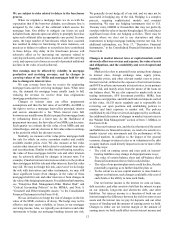SunTrust 2014 Annual Report Download - page 25
Download and view the complete annual report
Please find page 25 of the 2014 SunTrust annual report below. You can navigate through the pages in the report by either clicking on the pages listed below, or by using the keyword search tool below to find specific information within the annual report.2
complimentary to a financial activity and which do not pose a
risk to the safety and soundness of a depository institution or the
financial system generally. To maintain its status as a financial
holding company, the Company and its banking subsidiary must
be “well capitalized,” and “well managed” and must maintain at
least a “satisfactory” CRA rating, failing which the Federal
Reserve may, among other things, limit the Company’s ability
to conduct these broader financial activities or, if the deficiencies
persist, require the Company to divest the banking subsidiary. If
the Company has not maintained a satisfactory CRA rating, the
Company will not be able to commence any new financial
activities or acquire a company that engages in such activities,
although the Company will still be allowed to engage in activities
closely related to banking.
There are a number of obligations and restrictions imposed
on bank holding companies and their depository institution
subsidiaries by federal law and regulatory policy that are
designed to reduce potential loss exposure to the depositors of
such depository institutions and to the FDIC deposit insurance
fund in the event the depository institution becomes in danger
of default or is in default. For example, pursuant to the Dodd-
Frank Act and Federal Reserve policy, a bank holding company
is required to serve as a source of financial strength to its
subsidiary depository institutions and commit resources to
support such institutions, which may include circumstances in
which it might not otherwise do so.
The Company and its subsidiaries are subject to an extensive
regulatory framework of complex and comprehensive federal
and state laws and regulations addressing the provision of
banking and other financial services and other aspects of the
Company’s businesses and operations. Regulation and
regulatory oversight have increased significantly over the past
four years, primarily as a result of the passage of the Dodd-Frank
Act in 2010. The Dodd-Frank Act imposes regulatory
requirements and oversight over banks and other financial
institutions in a number of ways, among which are (i) creating
the CFPB to regulate consumer financial products and services;
(ii) creating the Financial Stability Oversight Council to identify
and impose additional regulatory oversight on large financial
firms; (iii) granting orderly liquidation authority to the FDIC for
the liquidation of financial corporations that pose a risk to the
financial system of the U.S.; (iv) requiring financial institutions
to draft a resolution plan that contemplates the dissolution of the
enterprise and submit that resolution plan to both the Federal
Reserve and the FDIC; (v) limiting debit card interchange fees;
(vi) adopting certain changes to shareholder rights and
responsibilities, including a shareholder “say on pay” vote on
executive compensation; (vii) strengthening the SEC's powers
to regulate securities markets; (viii) regulating OTC derivative
markets; (ix) restricting variable-rate lending by requiring the
ability to repay to be determined for variable-rate loans by using
the maximum rate that will apply during the first five years of a
variable-rate loan term, and making more loans subject to
provisions for higher cost loans, new disclosures, and certain
other revisions; (x) changing the base upon which the deposit
insurance assessment is assessed from deposits to, substantially,
average consolidated assets minus equity; and (xi) amending the
Truth in Lending Act with respect to mortgage originations,
including originator compensation, minimum repayment
standards, and prepayment considerations.
One of the more important changes instituted by the Dodd-
Frank Act is the requirement for twice-annual stress tests of the
Company and its bank. The performance of the Company under
the stress tests and the CCAR determine the capital actions the
Company will be permitted by its regulators to take, such as
dividends and share repurchases. Due to the importance and
intensity of the stress tests and the CCAR process, the Company
has dedicated significant resources to comply with stress testing
and capital planning requirements. These changes have
profoundly impacted our policies and procedures and will likely
continue to do so as regulators adopt regulations going forward
in accordance with the timetable for enacting regulations set forth
in the Dodd-Frank Act.
The Dodd-Frank Act imposed a new regulatory regime for
the OTC derivatives market, aimed at increasing transparency
and reducing systemic risk in the derivative markets, such as
requirements for central clearing, exchange trading, capital,
margin, reporting, and recordkeeping. Jurisdiction is broadly
shared by the CFTC for swaps and the SEC for security-based
swaps. In 2012 and 2013, the CFTC finalized most of its core
regulations, triggering a phased-in compliance period
commencing in late 2012 and continuing throughout 2013. The
Bank provisionally registered as a swap dealer with the CFTC
and became subject to new substantive requirements, including
trade reporting and robust record keeping requirements, business
conduct requirements (including daily valuations, disclosure of
material risks associated with swaps and disclosure of material
incentives and conflicts of interest), and mandatory clearing of
certain standardized swaps designated by the CFTC, such as
most interest rate swaps. The SEC has proposed most of its core
regulations for security-based swaps but most of its new
requirements await final regulations, which are expected to be
similar to the CFTC rules for swaps. The Company's derivatives
business is expected to become subject to additional substantive
requirements, including margin requirements in excess of
current market practice, increased capital requirements and
exchange trading requirements. These new rules collectively will
impose implementation and ongoing compliance requirements
for the Company and will introduce additional legal risk, as a
result of newly applicable anti-fraud and anti-manipulation
provisions and private rights of action.
Under the Dodd-Frank Act, the FDIC has the authority to
liquidate certain financial holding companies that are determined
to pose significant risks to the financial stability of the U.S.
(“covered financial companies”). Under this scenario, the FDIC
would exercise broad powers to take prompt corrective action to
resolve problems with a covered financial company. The Dodd-
Frank Act gives the Financial Stability Oversight Council
substantial resolution authority, which may affect or alter the
rights of creditors and investors in a resolution or distressed
scenario. The FDIC may make risk-based assessments of all bank
holding companies with total consolidated assets greater than
$50 billion to recover losses incurred by the FDIC in exercising
its authority to liquidate covered financial companies. Pursuant
to the Dodd-Frank Act, bank holding companies with total
consolidated assets of $50 billion or more are required to submit
resolution plans to the Federal Reserve and FDIC providing for
the company's strategy for rapid and orderly resolution in the
event of its material financial distress or failure. In September
2011, these agencies issued a joint final resolution plan rule




